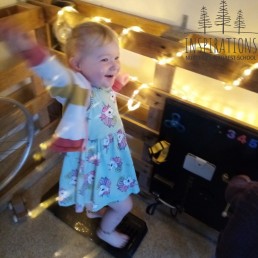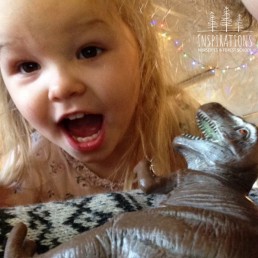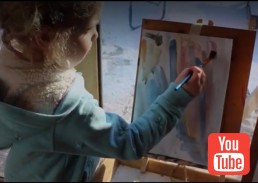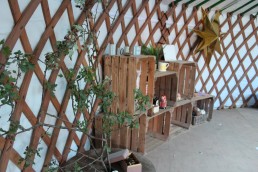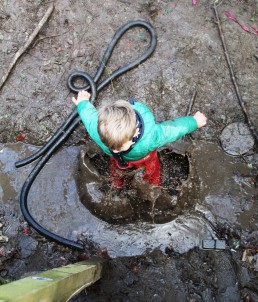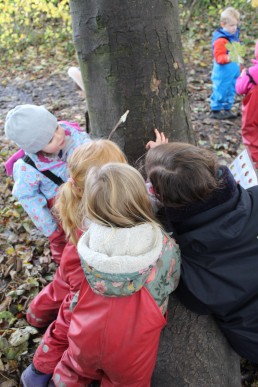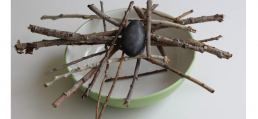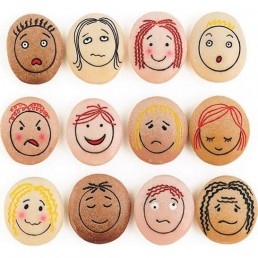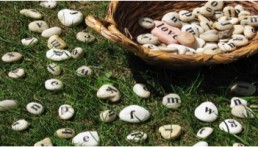Being Two- What are Schemas?
Welcome to part two of our focus on Being Two. This week we take a look at schemas, what they are, how our toddler room supports them, and ways to support this at home.
Have you made a cup of tea today, switched a light on, picked a pen off the floor and moved it to a flat surface to avoid it rolling off again? Then you have used schemas today without even realising it.
 A schema, put simply is like a mental model, a set of instructions we act out in our brain based on what has been successful in the the past. Whilst we come across schemas every time we learn something brand new, as you can imagine this happens the most at 2 and 3 years old.
A schema, put simply is like a mental model, a set of instructions we act out in our brain based on what has been successful in the the past. Whilst we come across schemas every time we learn something brand new, as you can imagine this happens the most at 2 and 3 years old.
Our toddler room is a HUB of schemas and is filled with opportunities to create these brain connections.
If I hit this will it break?
Whilst in may appear our little ones are rampaging through rooms causing chaos perhaps it helps to change our perspective and remember they are simply creating cognitive blue prints that set them up for life.
What happens if i drop this? Does this bounce? If I hit this will it break?
The Main Types of Schemas
Below are some examples of Schemas and how they are supported within the provision:
- Transporting – Moving objects or themselves from place to place. Moving things
with their hands. Bags, pots, pans, containers, sad. - Rotation – Turn and rotate objects or themselves. Roll their bodies, playing with toys
that spin, twist, and turn or even ride bikes. They could use Tyres, Wheels, Cable
reels and cars to explore this interest. - Enclosing – Join lines or build structures with objects such as bricks, magnets, or
malleable materials to form enclosures/models. - Connecting – Joining things together, fastening or tying things. Separating or
disconnecting construction etc. - Positioning- Our loose parts ethos lends its self well to this schema, lining things up, ordering different sized objects.
- Enclosing or enveloping- There is always a large cardboard box on the go in our toddler room setting for the children to climb into. But this can also be seen with sand or soil or fabric.
- Transforming- Messy play- gloop, water trays, mark making



I have attached a link that details further Schemas and how you at home can support these at home.
http://www.flyingstart.uk.com/wp-content/uploads/2014/08/Schema.pdf

Being Two
This Month we are focusing on our middle room at nursery, the toddler room, also known as our Honeybees room. Being two is more commonly referred to as the ‘Dreaded Twos’ or ‘Terrible Twos’; a term we find very unjust and instead celebrate this age with the phrase ‘Terrific Twos'.
Terrific Twos
It is very easy to conclude that your Toddler is in the midst of the ‘Terrible two’s’ when they act up and try push your buttons, especially when you are faced with patience testing tantrums.
It is important to remember that they are experiencing so many emotions and ultimately navigating their way into becoming tiny humans. They do not mean to drive you to the bottle of wine sat in your fridge, they are just growing and learning whilst showing you who they are and that being two really is terrific.
Adventure and Independence
In our eyes being a two year-old is about adventure and independence, traits we
feel are continuing to shape them after the transition from Baby to Toddler.

The Toddler room, or the Honeybee’s room as we refer to it is set up to allow the above,
and is a large area both indoors and out to move around freely, with many areas of
provision to explore and investigate. Whilst these areas are being slowly destroyed by tiny
hands and feet, friendships are being formed, and language is continuing to develop by
using simple sentences to share feelings, experiences and thoughts. They become more
aware of others feelings, and they are starting to understand boundaries and routines, as
well as listening with interest and understanding simple questions.
Milestones - Potty Training
Being Two also comes with it's challenges and a certain milestone is often met during this
period of their lives… Potty Training! Early signs that they may be transitioning
to this stage include awareness and communication. From telling you that they have done
something in their nappy to expressing the urge to go, these are all clear indictors that the
time is right and you should go with it and know that we are always their to support you. Remember that children develop at their own pace and they may not be ready to be potty trained until later.

Here are some links to books and tips for support-
https://www.amazon.co.uk/s?k=potty+training+books+for+toddlers&crid=BLJ3UFJL3K9O&sprefix=potty+training+%2Caps%2C192&ref=nb_sb_ss_ts-doa-p_3_15


Children are not things to be moulded, but people to be unfolded- Jess Lair
Next week we will focus on the importance of schemas, with some tips to supporting young children's language development. In the meantime if you've had a tough day, you've passed bath time and skipped straight to bedtime, you're still doing a great job. Remember it is this age that children are making new connections in their brain, pushing boundaries and learning vocabulary at rapid speed. We have to give credit to them for all this multitasking, whilst keeping our silliness alive, reigniting our imagination, and providing daily entertainment.
Although there can be some hard times amongst the great times if we start to see the world through their perspective we might all agree that life as a toddler can be challenging but also very fun.
-Ashleigh
Seekers of Meaning
New Video
Over the last few weeks I have been filming the children as they explore the Art Studio. To read more about our Art studio you can go back to last weeks blog.
The children's current shared interest is construction and building houses from clay, bricks, sticks and blocks. Some of that is captured in our brand new video that you can watch here-
https://www.yout ube.com/watch?v=4-59qb9GgdQ
ube.com/watch?v=4-59qb9GgdQ
Pre-School at Adel
Are you longing to peer into the future, catch a glimpse of normality resuming once again? I think we can agree this is going on longer than we initially imagined, but here we are. We are still in this together, and we hope during these times of increased social distancing you can still maintain social connections online, just like those in this news story that brought a smile to our faces. https://www.bbc.co.uk/news/av/uk-55732174
So we start this blog by asking, how are you, and what are you grateful for? We are grateful to have our Inspirations Nurseries families that continue to bring a sense of community.
Last week our blog focused on our Horsforth Pre-School, so this week we hand over to Deborah our manager at Adel to talk about our other Inspirations Nursery only 10 minutes away.
Welcome to Adel
At Adel we take children from the age of three, to starting school. Like Horsforth, we follow the Reggio Emilia Approach, which comprises of loose parts, mirrors and reflection, natural resources and investigation of up-cycled and recycled trinkets and materials.



Our setting is within the grounds of Adel St John the Baptist Primary School which is surrounded by beautiful woods and trees. There’s a well-equipped natural garden with a climbing wall, workbench, piano, mud kitchen and bikes. We have the use of the super large playing field and the conservation area which we use twice weekly for Forest School.
Our planning involves the outdoors as much as indoors and the children can choose where they would like to play.
Inside we have a very spacious room with areas to promote learning wherever the children choose to be.
Set Out to Inspire
The aim of our pre-school environments is to inspire the children to want to explore and learn. We have a maths, literacy, construction, small world, home and creative area of which all have natural resources for the children to explore and a wide range of loose parts to promote maths, communication, imagination and problem solving.



After observing the children’s common interests, we plan as a team to add resources and challenges to the areas and talk to the children about what they know and what they want to know, and how they would like to learn.
The children’s key worker also plans for their key children’s individual interests to support and provide opportunities to progress in all areas of development. As we are a pre-school we encourage independence and all skills necessary for school readiness, such as being able to express their own needs, listen to others and stories, separate from their carer, independent self-care, and understanding of British Values which encourages respect for ourselves and others.
Phonic, Spanish and Creativity
We teach phonics which is differentiated to meet and challenge each child’s individual ability. At Adel we also introduce Spanish to the children; an introduction to languages through songs, games and activities promoting enthusiasm with learning languages later in school. We also have our own Atelierista who comes in 3 times a week to deepen creative projects in smaller groups.

Throughout both our Pre-School settings we support your children in becoming strong independent learners, enabling them to think critically and outside the box. Their use of imagination and their understanding of the world, alongside their ability to problem solve, will stand them out from the crowd and give them a head start in life.
If you love our nursery as much as we do, have any questions or are interested in joining us check out more on the website here-http://simonr30.sg-host.com/our-settings/adel/ or contact- deborah@inspirationsnurseries.co.uk
Pre-School at Horsforth
Happy New Year to everyone, it sure has been an eventful start to the year as we continue to tackle a pandemic with 3 inches of snow thrown in to test us. But hope and positivity prevails, and we really valued your responses to our previous blog on the little steps we can all take to create a more sustainable year.
We thought we would start the year of blogs by taking a look at our Pre-School Settings across Horsforth and Adel. Currently our Pre-School bubble at Horsforth has closed, so for those affected we are posting daily activities and zooms for the children, you can find all the information you need on Tapestry.
We start by looking back at 2018- the time we implemented the Reggio Approach into our classrooms, changed our name from Dolphins to Inspirations, and rebuilt our entire Pre-School area. This change meant moving the Toddler Room into the old Pre-School room, opening up a second Baby Room, and building a Yurt, Outdoor Class Room and Art Studio on the patch of un-used grass land behind our nursery.
Our Yurt



Flattening the land for our Mongolian Yurt was quite the task, over the spring months of 2018 the changes were finalised and after calling in help from some of our parents, together with Colin the Yurt was erected in just a couple of days. The Yurt is a unique space and feature at Inspirations that provides just one of many learning areas for our Pre-School children. It is a cosy space to warm up in adverse weather and to eat their meals during winter. The yurt is filled with literacy areas, maths areas, open ended resources and books for reading and researching. See more about our Yurt here- http://simonr30.sg-host.com/our-yurt/
Outdoor Classroom



Our children are predominantly outdoor learners, and our outdoor classroom is a constantly changing space that matches the children's interests and mirrors seasonal changes. Adapting our classroom to match their interests invites our curious young minds to explore and discover, and is the perfect space for them to unleash their creativity.
No Fear of Failure
Throughout our Pre-School areas room Reggio Emilia is of course the guiding principle, and our spaces reflect that. Our Project based approach provides the backbone of their learning, so it is important that our environment and educators support their creative thought process without any fear of failure.
Exciting News
 This January are excited to announce a brand new Room Leader for our Pre-School room. Jennie is an experienced Reggio inspired Early Years Educator who over the course of the last 15 years has worked in Dubai, Japan, Angola and Vietnam and has been to Reggio Emilia three times. We’re very excited that she has joined our team and brings her passion for our pedagogy and supporting children through child- led learning. Her email address is jennie@inspirationsnurseries.co.uk if you would like to get in touch.
This January are excited to announce a brand new Room Leader for our Pre-School room. Jennie is an experienced Reggio inspired Early Years Educator who over the course of the last 15 years has worked in Dubai, Japan, Angola and Vietnam and has been to Reggio Emilia three times. We’re very excited that she has joined our team and brings her passion for our pedagogy and supporting children through child- led learning. Her email address is jennie@inspirationsnurseries.co.uk if you would like to get in touch.
If you’re interested in your child joining our Pre-School over 3’s room please take a look at our website and get in touch with Kayleigh@inspirationsnurseries.co.uk.
 In next weeks blog we will be taking a look at our Pre-School setting over at Adel. In the mean time stay safe in the snow and please do send in any photos you have out exploring the weather. We will select some highlights to share on our social media this weekend.
In next weeks blog we will be taking a look at our Pre-School setting over at Adel. In the mean time stay safe in the snow and please do send in any photos you have out exploring the weather. We will select some highlights to share on our social media this weekend.
"We value space to create a handsome environment and its potential to inspire social, affective and cognitive learning. The space is an aquarium that mirrors the ideas and values of the people who live in it" -Loris Malaguzzi
- Nathalie
Every Cloud...
https://www.youtube.com/watch?v=6AAcMqAZlXU
I followed the children into the local woods to see what they got up to on their journey into the forest, you can watch the video on YouTube by following the link above. Unfortunately due to Covid regulations this was the last walk into the woods for a month or so, but every cloud has a silver lining. The children now have their forest school sessions on-site and it has inspired us to make the most out of what we have here.
Forest School On Site

We have added some rope swings over the stream, and a slide down to the forest school area. This week during the forest school sessions our 3 and 4 year olds have been learning how to use a pneumonic drill, they’ve made oat pancakes on the outdoor campfire and are learning how to put on their outdoor suits independently. Staying on-site during forest school has also opened up some team building opportunities and chances to talk and listen around the campfire.
‘I love every shape, every colour and every number’- James 4
It won’t be long until the children can head back into the woods, but in the mean time you’ll find them knee deep in the stream, making art against the bark of trees and mastering our new rope tyre obstacle course. Sometimes it takes a little set back to encourage you to make the absolute most out of what you already have.


The Benefits of Forest School
At Inspirations we value greatly our outdoor environments which are extensive and include the use of our local Horsforth woodland at Hunger Hills. Our passion for outdoor learning and forest school comes from a deep understanding and appreciation for the ethos. The pedagogy was developed in Sweden in the 1950’s and the approach focuses on the natural environment being utilised, not only as an area where children can blow off excess energy but more importantly where children are given the opportunity to immerse themselves in nature.

http://simonr30.sg-host.com/our-settings/forsest-school/
Forest school children develop an appreciation and deep seated love of nature and are able to explore and learn from all that the environment has to offer, at a pace that suits them.
'Lead their own Learning'
The forest school ethos allows for each individual child to lead their own learning journey. They find their own pace, interests and methods of learning and attainment that best suit them. There is no pressure, no preconceived results, no adults determining a beginning or end to their project or interest.
Adults of course play a vital role one which is supportive and patient, they build strong positive relationships which children know they can trust and count on. The Adults help children take managed risks encouraging children to consider, they ask questions and encourage with a hands-on approach which helps supports critical thinking.


Resilience and Determination
Forest school children are shown to be ahead of their peers by the time they start school at the age of five. They show confidence, are very willing to ‘have a go’ and not be deterred by failed attempts. They are resilient and eager to keep trying until they find a positive solution to a problem. It is shows they are effective problem solvers who work well within a team, exhibiting high levels of motivation and concentration to any task facing them.
The forest learning environment also creates strong communicators and gives children a deep level of understanding about the word around them. They are socially advanced, understanding feelings and consequences of their behaviour and are more likely to think before they act. Naturally children who spend time in wide open spaces where the floor is uneven, who have trees to climb and weather to navigate are more confident in their own physical abilities. They are more prone to want to be outdoors as adults and as a result are more healthier, happier individuals.


There are several studies on the benefits of forest school and outdoor learning philosophy. These studies are becoming more prevalent as the ethos has slowly become more popular. Below are a few links to the most recent studies showing the benefits mentioned in our blog above.
https://www.forestschoolassociation.org/new-research-a-longitudinal-study-on-forest-school/
- Nicola

Stick and Stone Balancing Activity
Resources – Sticks, a stone and a bowl
Implementation
Use your problem solving and fine motor skills to lay your sticks out and balance the stone so it doesn’t fall through into the bowl. As a challenge limit the amount of sticks and use a smaller stone!
Intent – Learning goals
Characteristics of Effective Learning
Playing and Exploring –
Being willing to ‘have a go’
- Initiating activities
- Seeking challenge
- Showing a ‘can do’ attitude
- Taking a risk, engaging in new experiences, and learning by trial and error
Active Learning –
Being involved and concentrating
- Maintaining focus on their activity for a period of time
- Showing high levels of energy, fascination
- Not easily distracted
- Paying attention to details
Keeping on trying
- Persisting with activity when challenges occur
- Showing a belief that more effort or a different approach will pay off
- Bouncing back after difficulties
Enjoying achieving what they set out to do
- Showing satisfaction in meeting their own goals
- Being proud of how they accomplished something – not just the end result
- Enjoying meeting challenges for their own sake rather than external rewards or praise
Creating and Thinking Critically
Having their own ideas
- Thinking of ideas
- Finding ways to solve problems
- Finding new ways to do things
Making links
- Making predictions
- Testing their ideas
Choosing ways to do things
- Planning, making decisions about how to approach a task, solve a problem and reach a goal
- Checking how well their activities are going
- Changing strategy as needed
- Reviewing how well the approach worked
Feelings Stones
Resources: Stones, pens/paint
For the body- Clay, mud, play dough or sticks
Implementation
In these unprecedented times we are all aware how important it is to be extra aware and look after our well being. Your children could use play dough to make a body and parents or children could draw pictures of a range of emotions on stones, so then each day your child can choose how they are feeling and talk about that emotion and the reasons why.


Intent- Learning Goals
Personal Social and Emotional Development – Managing feelings and behaviour
22-36 months
- Can express their own feelings such as sad, happy, cross,scared, worried.
30-50 months
- Aware of own feelings, and knows that some actions and words can hurt others’ feelings.
Personal Social and Emotional Development – Self confidence and self awaremess
22-36 months
- Expresses own preferences and interests.
30-50 months
- Can select and use activities and resources with help.
- Welcomes and values praise for what they have done.
- Enjoys responsibility of carrying out small tasks.
- Shows confidence in asking adults for help.
40-60 months
- Confident to speak to others about own needs, wants, interests and opinions.
- Can describe self in positive terms and talk about abilities.
Communication and Language – Speaking
22-36 months
- Uses language as a powerful means of widening contacts, sharing feelings, experiences and thoughts.
40-60 months
- Uses talk to organise, sequence and clarify thinking, ideas, feelings and events.
Impact
How did this activity go? Please use this space to record any findings, adaptions, reflections and quotes from your children. We would love you to email them back to us or share them on Tapestry, Instagram or Facebook.
Letter Stones Activity
Resources- Stones, Pens or paint
Implementation
Go on a scavenger hunt in the beautiful sunshine for more stones. Children can practise their name by matching the letter stones to a written name card. If they already know how to form their name they can make it with the stones independently. The stones can be further used to make other names your children may know such as mummy or daddy, or a sibling’s name or even a favourite story character’s name copied from a book, e.g. Stick Man or Stanley! You could muddle up some familiar names or words for your child to form correctly. Your children may be able to copy or independently form other familiar or significant words and simple sentences using the stones, or even order the stones alphabetically.

Intent- Learning Goals
Literacy – Reading
30-50
- Recognises familiar words and signs such as own name and advertising logos.
40-60
- Hears and says the initial sound in words.
- Links sounds to letters, naming and sounding the letters of the alphabet.
- Begins to read words and simple sentences
Literacy – Writing
40-60
- Uses some clearly identifiable letters to communicate meaning, representing some sounds correctly and in sequence.
- Writes own name and other things such as labels and captions.
- Attempts to write short sentences in meaningful contexts.
Impact
Please use this space to record any findings, adaptions, reflections and quotes from your children. We would love you to email them back to us or share them on Tapestry.
